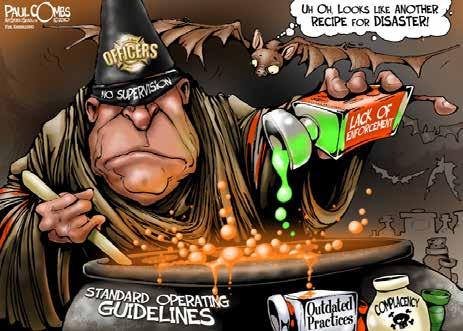
4 minute read
The Rural Firefighter: Corey Conrady
Drummond FD
This article is dedicated to all fire departments -- not just rural -- and the kinds of things we deal with as firefighters who live and serve in the communities we have grown up in.
Building a Culture of Safety
What is culture? The definition is “an umbrella term that encompasses the social behavior, institutions, and norms found in human societies, as well as the knowledge, beliefs, arts, laws, customs, capabilities, and habits of the individuals in these groups. Culture often originated from or is attributed to a specific region or location.” Now, what is a culture of safety? Safety Culture is the way safety is perceived, valued, and prioritized in an organization. It reflects the real commitment to safety at all levels in the organization. It has also been described as “how an organization behaves when no one is watching”. The National Fallen Firefighters Foundation (NFFF) has asserted that the culture of the fire and emergency service is a major contributor to the fatal trend in firefighters’ health and safety (Siarnicki, 2010). This culture has not been concisely defined, but the literature suggests both that it exists as a stand-alone concept and that it has unique characteristics that are uncommon to non-uniformed professions. This effort is directly related to three of NFFF’s 16 Firefighter Life Safety Initiatives (FLSIs). FLSI 1, which states: Define and advocate the need for a cultural change within the fire service relating to safety; incorporating leadership, management, supervision, accountability, and personal responsibility (NFFF, 2011), is an overarching initiative, acknowledging that the organizational culture of the fire service must undergo a change to accept the other 15 recommendations. Without understanding the culture within a fire and emergency service organization, it is likely that changes called for in the other 15 initiatives cannot be successfully implemented or sustained. (U.S. Fire Administration National, Safety Culture Change Initiative, a Study of Behavioral Motivation on Reduction of Risk-Taking Behaviors in the Fire and Emergency Service). This study conducted by the U.S. Fire Administration concluded that many internal factors are at play to determine a culture within an organization, “many interrelated factors must be addressed in order to produce a significant change in outcomes in terms of reducing line of duty injuries and deaths and improving overall firefighter safety and health.” The study also states that “unsafe attitudes and behaviors often prevail in spite of the common knowledge that there are less risky alternatives that could result in fewer deaths, injuries, and illnesses. In fact, it was noted that efforts to promote health and safety were often met with resistance and scorn, reinforcing the notion that they created conflict with established
attitudes, assumptions, and values. The existing system of assumptions and beliefs reinforces particular values: ● Every LODD is automatically labeled as heroic, no matter the circumstances (versus an occupational fatality that is preventable). ● Recommendations to follow standard operating procedures and exercise appropriate caution are described as cowardly. ● The urgency of quickly arriving at the scene of an emergency justifies driving in a manner that endangers the lives of other motorists and pedestrians who may be encountered en route, as well as the responders themselves.” So what is this all saying? 1. Building a culture of safety then begins at the top and requires “buy-in” from everyone. 2. Every injury or fatality can be prevented. 3. Caution should be everyone’s SOP. 4. Driving too fast endangers everyone. As we continue in this series, we will continue to look at Building a Culture of Safety, not just in our departments, but in our lives outside. We will Help is available if you need immediate continue to look at the 16 Life Safety Initiasupport in Oklahoma. Contacts include: tives and how we can implement them in our • Warriors Rest Foundation -- departments. Brett Key at 405-252-7489
Sources
• First Responders Against Suicide -- The National Fallen Firefighters Foundation leads
Facebook page is available to message an “Everyone Goes Home” Firefighter Life Safety
First Responders in Oklahoma Initiatives” plan on their web page https://www. • National Suicide Prevention Lifeline -- everyonegoeshome.com/16-initiatives that lists 16 800-273-8255 (or go to website for chat) attitude initiatives, we as the fire service should • National Helpline -- 800-662-HELP (4357) strive to implement in our departments. • Crisis Text Line -- Text HOME to 741741 The National Safety Culture Change Initiative • OSFA -- 405-424-1452 (will respond with (NSCCI) was developed to advocate for the need help within 48 hours) for culture change for health and safety within the • Corey Conrady 580-540-0970, call or text fire service. This effort is led by the International me anytime Association of Fire Chiefs (IAFC), in partner• Oklahoma Fire Service Chaplains -- Facebook page lists four area contacts ship with the U.S. Fire Administration (USFA). https://www.ffsafetyculture.org/
In an emergency, contact Pastor Gary Download the report at https://www.usfa.fema. Lillie (Hawley Fire) 580-541-5980 gov/downloads/pdf/publications/fa_342.pdf









